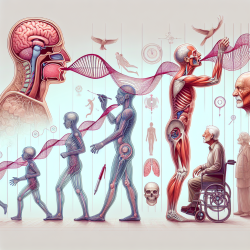Understanding the Impact of Type 1 Diabetes on Brain Development in Young Children
As practitioners in the field of speech-language pathology, understanding the impact of physiological conditions on cognitive and neural development is crucial. A recent study titled "Neuroanatomical Correlates of Dysglycemia in Young Children With Type 1 Diabetes" offers insightful data on how early-onset Type 1 Diabetes (T1D) can affect brain development. This blog aims to provide an overview of the study's findings and discuss how practitioners can leverage this information to improve outcomes for children with T1D.
Key Findings of the Study
The study investigated the neuroanatomical differences in young children with T1D compared to age-matched controls. Using structural magnetic resonance imaging (MRI), researchers found significant variations in gray matter volume (GMV) between the two groups. Notably, children with T1D showed decreased GMV in bilateral occipital and cerebellar regions and increased GMV in the left inferior prefrontal, insula, and temporal pole regions.
Furthermore, within the T1D group, hyperglycemic exposure was linked to decreased GMV in medial frontal and temporal-occipital regions, while increased GMV was observed in lateral prefrontal regions. These findings suggest that early-onset T1D affects brain regions associated with typical cognitive development, potentially leading to cognitive deficits.
Implications for Practitioners
Understanding these neuroanatomical changes is vital for practitioners working with children with T1D. Here are some ways this research can inform practice:
- Early Intervention: Recognizing the potential for cognitive deficits in children with T1D underscores the importance of early intervention. Speech-language pathologists can work closely with other healthcare providers to monitor cognitive development and address any emerging issues promptly.
- Individualized Therapy Plans: Given the variability in how T1D affects brain development, therapy plans should be tailored to the individual needs of each child. Practitioners can use data from continuous glucose monitoring to better understand the child's glycemic exposure and its potential impact on cognitive functions.
- Collaborative Care: Collaboration with endocrinologists, neurologists, and other specialists is crucial to provide comprehensive care. Sharing insights from neuroimaging studies can help create a holistic approach to managing T1D and its effects on brain development.
Encouraging Further Research
While this study provides valuable insights, it also highlights the need for further research. Longitudinal studies could help elucidate the developmental trajectory of brain changes in children with T1D and the long-term cognitive outcomes. Additionally, exploring interventions that can mitigate the neuroanatomical impact of T1D could lead to improved therapeutic strategies.
For practitioners interested in delving deeper into this topic, reading the full research paper is highly recommended. It provides a comprehensive analysis of the methods and findings, offering a solid foundation for further exploration and application in clinical practice.
To read the original research paper, please follow this link: Neuroanatomical Correlates of Dysglycemia in Young Children With Type 1 Diabetes.










